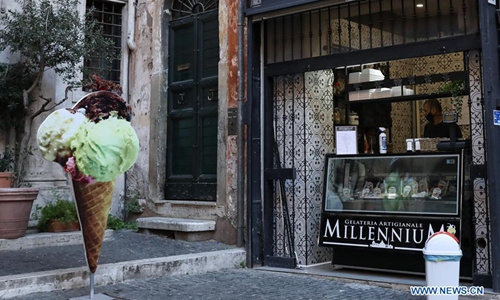
A man waits for customers at an ice cream shop in Rome, Italy, May 12, 2020. (Xinhua/Cheng Tingting)
A further 172 COVID-19 patients had died in the past 24 hours in Italy, bringing the country's death toll to 30,911, out of total infection cases of 221,216, according to fresh figures on Tuesday.
Recoveries jumped by 2,452, bringing the nationwide total to 109,039 -- up from 106,587 recoveries on Monday. Nationwide, the number of active infections fell by 1,222 to 81,266, according to Italy's Civil Protection Department.
Of those who tested positive for the coronavirus, 952 are in intensive care -- down by 47 compared to Monday, and 12,865 are hospitalized with symptoms -- down by 674 over the past 24 hours. The rest 67,449 people, or 83 percent of those who tested positive, are isolated at home.
The Lombardy region, whose capital is Milan, still had the lion's share of active cases (30,675), followed by its neighbors Piedmont (13,184), Emilia-Romagna (6,801) and the Veneto region whose capital is Venice (5,190).
In the rest of Italy's 20 regions, active case totals ranged from 4,273 in the central Lazio region, where Rome is located, to 104 in the northern Valle d'Aosta region in the Alps.
"The right path"
During a press conference earlier in the day, Coronavirus Emergency Commissioner Domenico Arcuri said with regards to the first week after the easing of lockdown restrictions that "Italians have given the rest of the world a good example with their cautious and prudent attitude as they embarked on Phase Two of this emergency."
"I think we're on the right path," Arcuri said. "The curve of the infection has normalized, and I am certain we will be able to manage Phase Two as we did Phase One (meaning the lockdown)."
He said that over the past few weeks "we have delivered 4,403 ventilators to hospitals throughout the country; last night, for the first time since the start of the emergency, the number of COVID-19 ICU patients dropped to under 1,000."
The extra ventilators will remain, and the country will soon "stop having to depend on imports of personal protection equipment."
"These are two significant differences between what was there before, and what will remain after" the emergency, Arcuri said.
He added that since May 1, 19 million surgical masks have been sold to the public at a fixed price of 50 euro cents (54.3 dollar cents) per mask.
"Unfortunately for speculators, the price is and will remain 50 cents," Arcuri said. "The speculation we observed in the past no longer exists, and it will not be back."
He also said that the Civil Protection Department has distributed 36.2 million masks to authorities in Italy's 20 regions -- 40 percent more than the previous week.
"Since the beginning of the emergency, we have distributed 208.8 million masks -- the regions now have 55 million masks in their warehouses," Arcuri said.
Italy has a population of just over 60 million inhabitants, according to ISTAT national statistics institute.
"Not enough to save tourism"
In a statement out Tuesday, the Bank of Italy said that while it is difficult to gauge the long-term economic fallout of the pandemic, "its effects will be of virulence that has never or rarely been experienced in the past."
In its monthly economic bulletin, the Italian central bank said the country's gross domestic product (GDP) contracted by 4.7 percent in the first quarter of the year.
This compared to the contraction of 0.3 percent in the fourth quarter of 2019 and growth of 0.3 percent in the first quarter last year, according to the Bank of Italy.
The government is working on 55-billion-euro (60 billion U.S. dollars) so-called "Recovery Decree" to shore up Italy's productive system, and drafts have been circulating, sparking objections from different sectors of the country's economic base.
In a joint statement, the Italian Association of Tourism Distribution (AIDIT), the Italian Association of Tour Operators (ASTOI), and the Italian Association of Travel and Tourism Agencies (Assoviaggi) warned that the measures contained in the draft decree don't go far enough.
If the Recovery Decree is approved as it is, "it will deliver the final blow ... against a sector that represents 13 percent of GDP and 15 percent of employment," the statement said.
Among their major objections is that in its current form, the draft decree would grant non-repayable loans to tourist firms with a turnover of up to 5 million euros.
"This cap must be eliminated," the associations claimed, arguing that it leaves out "all the medium and large tourist companies, including over 99 percent of tour operators and all the medium and large business travel, incoming, and events planning firms."
According to Demoskopika market research firm, if there is "a slow exit from the COVID-19 health emergency, coupled with a tardy injection of liquidity into the economic system," over 40,000 Italian tourism-related businesses will have to declare bankruptcy by the end of the year, with losses of almost 10 billion euros in turnover.
This "entrepreneurial mortality rate" would lead to the loss of 184,000 jobs across Italy, according to Demoskopica.
"Much will depend on the speed with which the institutions help the system come out of the emergency," Demoskopica President Raffaele Rio said in a statement out April 11.
According to international tourism numbers released by the Bank of Italy on Tuesday, over 62 million foreigners came to visit this Mediterranean country in 2018, rising to more than 65 million such visitors in 2019.
